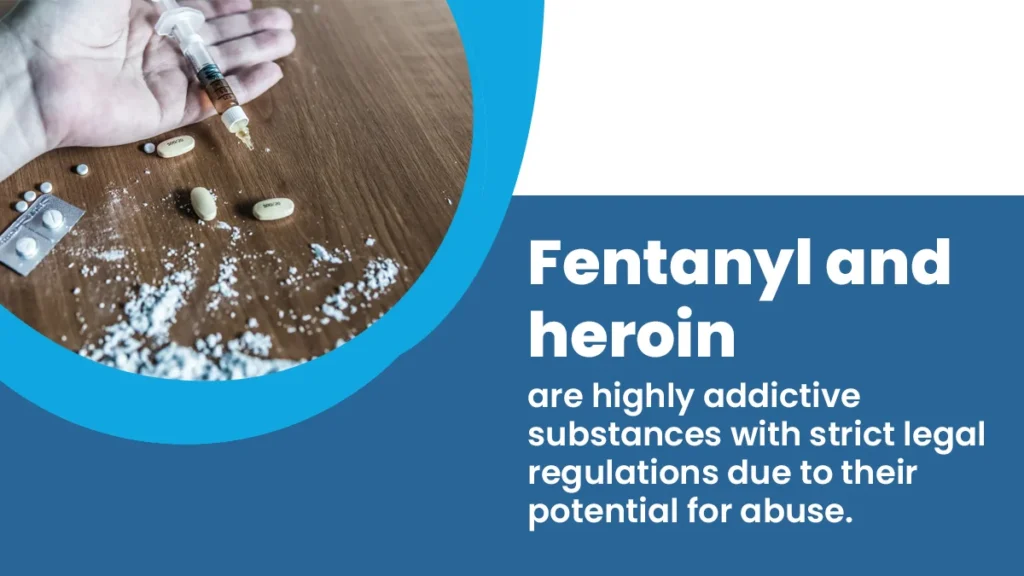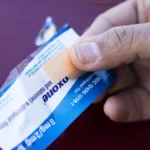Fentanyl and heroin are two opioids that stand at the forefront of the ongoing discussion surrounding illicit drugs. Both belong to the opioid category, but they differ significantly in terms of their chemical structure, potency, and societal impact.
Understanding these differences is crucial for policymakers, healthcare professionals, and individuals grappling with addiction. Read on to explore the critical differences between fentanyl and heroin and their addiction potential.
Key Takeaways
Fentanyl and heroin are potent opioids that intertwine in a deadly embrace, masking transient relief with their hazardous effects. Keep reading!
- Fentanyl and heroin can lead to profound physical and mental changes, leading to fatal outcomes.
- Fentanyl and heroin are highly addictive substances with strict legal regulations due to their potential for abuse.
- Recovery from fentanyl and heroin addiction often involves various treatment options to help people rebuild their lives.
The Haven detox-Little Rock is here to help you overcome various types of addiction. Call us at (501) 271-3342 to get more information.

Overview Of Fentanyl And Heroin
Fentanyl is a powerful synthetic opioid pain reliever. It’s similar to morphine but is much stronger. Doctors prescribe it for severe pain, like after surgery or for cancer patients. However, illegally made fentanyl is also sold on the streets. It’s often mixed with other drugs like heroin or cocaine, which can make it even more dangerous.
Heroin is an illegal opioid drug made from morphine, a natural substance from the opium poppy plant. People use it for its euphoric effects and to relieve pain. It’s usually found as a white or brown powder or as a black sticky substance known as black tar heroin. Heroin can be injected, snorted, or smoked, and it’s highly addictive.
Both fentanyl and heroin are highly addictive and can lead to overdose. Fentanyl is especially dangerous because it’s much more potent than heroin. Overdosing on fentanyl can happen quickly because it’s so potent. Both drugs can cause respiratory depression, where breathing slows down or stops, leading to death. It’s important to avoid using these drugs and seek help if struggling with addiction.
Effects Of Fentanyl And Heroin On The Human Body
Fentanyl and heroin are potent drugs that profoundly affect the human body. These substances belong to the opioid class, known for their ability to alleviate pain and induce feelings of euphoria. However, the use of fentanyl and heroin comes with immediate and long-term consequences that can impact both physical and mental health.
Immediate And Long-Term Effects Of Fentanyl
Fentanyl, a potent opioid, swiftly affects the body. It causes immediate effects like intense euphoria, drowsiness, and confusion. Breathing may slow down dangerously, leading to overdose and death. Long-term use can result in addiction, respiratory issues, and weakened immune function. Fentanyl also increases the risk of accidental overdose due to its potency.
Immediate And Long-Term Effects Of Heroin
Heroin rapidly impacts the body upon use. Immediate effects include a rush of pleasure, drowsiness, and slowed breathing. Long-term use can lead to addiction, collapsed veins, and liver and kidney disease. Additionally, heroin abuse can result in mental health problems such as depression and anxiety. Over time, heroin weakens the body’s overall health and increases the risk of fatal overdose.
Addiction Potential Of Fentanyl And Heroin
The addiction potential of substances like fentanyl and heroin casts a shadow over countless lives. Both substances act on the brain’s reward system, leading to dependence and addiction. Exploring the mechanics of fentanyl and heroin addiction sheds light on why individuals find it challenging to break free from their grip.
The Mechanics Of Fentanyl Addiction
Fentanyl hooks onto brain receptors quickly, causing intense euphoria. This rapid bonding creates a mighty craving for more. Over time, the brain adapts, needing more fentanyl to achieve the same high. This cycle strengthens addiction, making quitting challenging.
The Mechanics Of Heroin Addiction
Heroin swiftly enters the brain, converting to morphine upon arrival. Morphine then binds to an opioid receptor, inducing pleasure and pain relief. Regular use alters brain chemistry, leading to dependence. Breaking free often requires comprehensive support and treatment.
Legal Status Of Fentanyl And Heroin
Both fentanyl and heroin are classified as illegal drugs by the Drug Enforcement Administration (DEA). While they belong to different types of opioids, they share similar effects on users. Fentanyl is a synthetic substance often used as a prescription medication for severe pain, but it’s also found in illegal drug markets. Heroin, on the other hand, is purely a street drug, not used for medical uses. Both drugs can lead to opioid overdose, which has contributed to the opioid epidemic in the country.
The main difference between fentanyl and heroin lies in their origins and strength. Fentanyl is much more potent than heroin, with a lower lethal dose. Due to its potency, fentanyl poses a higher risk of overdose, even in small amounts. While both drugs are addictive, fentanyl’s potency can lead to quicker development of tolerance and addiction among users. Medical professionals and law enforcement agencies are actively combating the illegal distribution of both drugs to address the opioid crisis.
The opioid epidemic affects Americans across age groups, with young adults particularly vulnerable. The National Center reports a rising rate of opioid overdoses, including both fentanyl and heroin overdoses. Illegal drug markets and dealers play a significant role in the distribution of these addictive drugs. To tackle the crisis, efforts are underway to educate the public, increase access to treatment, and enhance law enforcement measures to curb the availability of these dangerous substances.
Treatment For Fentanyl And Heroin Addiction
Addiction to potent substances like fentanyl and heroin can have devastating effects, but effective treatment options are available. By combining medical intervention with rehabilitation, individuals can overcome dependence and reclaim their lives. Understanding these treatment approaches is crucial in supporting individuals on their journey to recovery.
Treatment And Rehab For Fentanyl Addiction
Fentanyl addiction treatment combines medications like buprenorphine and methadone with counseling. These medications lessen withdrawal symptoms and cravings by binding to brain receptors. Rehabilitation programs supplement with therapy to address psychological aspects, offering support groups and counseling for healthier coping mechanisms.
Treatment And Rehab For Heroin Addiction
Heroin treatment includes medications like buprenorphine and methadone alongside counseling. These medications reduce cravings and withdrawal symptoms. Rehabilitation programs focus on understanding addiction’s roots, teaching coping strategies, and providing group support to prevent relapse and promote recovery.
Comparing Treatment Approaches
Both fentanyl and heroin addiction treatments involve medications like buprenorphine and methadone to manage withdrawal and cravings. Individual responses to medications vary, necessitating tailored treatment plans. Rehabilitation programs offer counseling and support groups to address underlying causes and teach coping skills for a successful recovery journey.
Societal Impact Of Fentanyl And Heroin
Fentanyl and heroin have had a profound impact on society in the United States, particularly concerning public health. Overdose deaths related to these opioids have surged in recent years, leading to what is often referred to as an opioid epidemic or crisis. Both prescription opioids and illicit drugs like heroin contribute to this crisis, causing immense suffering and loss within communities.
The societal impact of deadly opioid overdoses extends beyond just the individual users to their families, friends, and broader communities. The ripple effect of opioid-related deaths can be devastating, leaving families shattered and communities grappling with grief and trauma. Moreover, the strain on healthcare systems and resources dedicated to disease control has become increasingly evident as the crisis persists.
Efforts to address the societal impact of fentanyl and heroin involve a multifaceted approach. This includes not only prevention strategies aimed at reducing opioid misuse and addiction but also initiatives to support those affected by addiction and overdose. In addition, addressing the root causes of opioid addiction, such as socioeconomic factors and access to healthcare, is essential in mitigating the societal repercussions of this crisis.
Frequently Asked Questions (FAQs)
Can fentanyl be absorbed through the skin?
Fentanyl can be absorbed through the skin, which is why it’s available in various transdermal patch formulations for managing chronic pain. The patches deliver a controlled amount of the drug through the skin into the bloodstream over an extended period.
However, it’s crucial to handle fentanyl patches carefully to prevent accidental exposure, as even small amounts absorbed through the skin can lead to overdose and potentially fatal respiratory depression. Therefore, following proper disposal procedures and avoiding direct skin contact with patches unless prescribed and applied under medical supervision is essential.
Does fentanyl feel differently than heroin?
Fentanyl and heroin differ in their effects despite both being opioids. Fentanyl is considerably more potent than heroin, leading to stronger and more rapid effects such as intense euphoria, sedation, and respiratory depression. Users may experience a shorter duration of action with fentanyl compared to heroin.
Additionally, fentanyl’s potency increases the risk of overdose and death, even with small doses. Heroin tends to produce a longer-lasting high with a slower onset, and its potency varies depending on purity and other factors. However, both drugs ultimately act on the same opioid receptors in the brain, inducing similar but distinct sensations.
Empower Yourself At The Haven Detox-Little Rock
If you or someone you know is struggling with addiction to fentanyl, heroin, or any other substance, don’t hesitate to seek help. The Haven Detox-Little Rock is here to assist you.
Our facility offers medically supervised detox to cleanse your body from harmful substances. Our residential rehab is committed to providing evidence-based treatment, therapies, and 24-hour support from addiction professionals.
We also provide vital nutrients and NAD IV therapy to replenish your body’s essential vitamins, minerals, water, and amino acids to facilitate a smoother recovery.
Contact us at (501) 271-3342 to learn more about our personalized treatment programs and take the first step towards a healthier, substance-free life.





